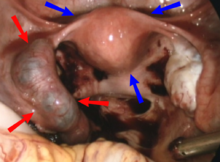Hämatosalpinx
| Klassifikation nach ICD-10 | |
|---|---|
| N83.6 | Hämatosalpinx |
| ICD-10 online (WHO-Version 2019) | |
Die Hämatosalpinx (von altgriechisch αἷμα haima, deutsch ‚Blut‘ und altgriechisch σαλπίγξ salpinx, deutsch ‚Eileiter‘) ist eine Ansammlung von Blut in einem oder in beiden Eileitern (lateinisch Tuba uterina).[1]

Ursache
BearbeitenAls Ursache kommen infrage:[2]
- Eileiterschwangerschaft
- Endometriose, die beiden häufigsten Ursachen
- Salpingitis und andere Entzündungen im Becken
- Tubentorsion (Verdrehung des Eileiters um die eigene Längsachse)
- Tubenkarzinom
- Trauma
- als Komplikation bei einem Hämatokolpos
Klinische Erscheinungen
BearbeitenDie klinischen Kriterien hängen von der Ursache ab, siehe jeweils dort.
Diagnose
BearbeitenDer erste und wegweisende diagnostische Schritt nach der klinischen Untersuchung ist die Sonografie. Häufig wird eine Laparoskopie notwendig sein.
Literatur
Bearbeiten- M. Nacharaju, V. S. Vellanki, S. B. Gillellamudi, V. K. Kotha, A. Alluri: A rare case of chronic ectopic pregnancy presenting as large hematosalpinx. In: Clinical medicine insights. Reproductive health, 2014, Band 8, S. 1–4; doi:10.4137/CMRH.S13110, PMID 24812530, PMC 4007565 (freier Volltext).
- C. L. Diehl, L. P. Gavrilova-Jordan, C. C. Coddington: Acute abdominal pain as a result of a ruptured hematosalpinx: a rare complication of an unusual müllerian anomaly. In: Journal of pediatric and adolescent gynecology, Juni 2009, Band 22, Nr. 3, S. e9–11; doi:10.1016/j.jpag.2008.02.005, PMID 19539197.
- T. Römer, B. Bojahr, G. Schwesinger: Treatment of a torqued hematosalpinx in the thirteenth week of pregnancy using gasless laparoscopy. In: The Journal of the American Association of Gynecologic Laparoscopists, Februar 2002, Band 9, Nr. 1, S. 89–92, PMID 11821614.
Weblinks
BearbeitenEinzelnachweise
Bearbeiten- ↑ Willibald Pschyrembel: Klinisches Wörterbuch. 266., aktualisierte Auflage. de Gruyter, Berlin 2014, ISBN 978-3-11-033997-0
- ↑ Radiopaedia